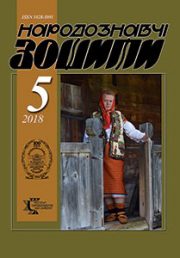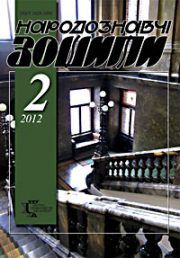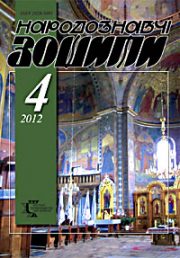The Ethnology Notebooks. 2021. № 3 (159), 555—562
UDK 392.10 (477.88) 394.2″18/19″
DOI https://doi.org/10.15407/nz2021.03.555
FOLK CLOTHING OF UKRAINIANS OF TRANSCARPATHIA IN RITUAL CULTURE AND TRADITIONAL BELIEFS
KOROL Vasil
- ORCID https://orcid.org/0000-0002-0471-2115
- Ph.D. of Sciences in History, Senior Researcher
- Of the Municipal Institution «Transcarpathian Museum
- of Folk Architecture and Life»
- of the Transcarpathian Regional Administration,
- Kapitulna 33a, 88000, Uzhgorod, Ukraine
- Contacts: e-mail: anshamach@gmail.com
KOTSAN Vasil
- ORCID https://orcid.org/0000-0003-0644-9725
- Candidate of Historical Sciences, Director of the Transcarpathian
- Museum of Folk Architecture and Life ZOR,
- Associate Professor of Archeology, Ethnology and Cultural Studies
- Uzhhorod National University,
- Contacts: e-mail: vasilkotsan@ukr.net
Abstract. The article deals with the use of certain components of traditional folk costumes in the ritual culture and traditional beliefs of Ukrainians in Transcarpathia. The authors consider magical and ritual functions of clothing, such as its formal features as the method of manufacture and wearing, belonging and purpose, nudity. The study, based on the source material and available literature, outlines the features of the use of folk costumes in rituals associated with the birth of a child, weddings, funerals, as well as individual holidays of the annual calendar cycle. Prospects for further research are to clarify and refine a number of iconic functions of clothing, outlining the ritual functions of such components of folk costumes as skirts, outerwear, men’s and women’s hats, jewelry, complementary elements of folk costume.
The main purpose of presented research is an attempt to consider relatively poorly studied features of clothing as a magical (serves as a human substitute, using as safety tools, disaster sending) and a ritual (marks certain ritual roles and features) symbol. Additionally, the authors pay attention to a number of significant clothing features with a set of formal indication (the material and its processing, the method of producing and wearing, nakedness, the color, new-old, appliance and mission).
The main sources for research of present problems served the authors filed materials, collected at the ethnographical expeditions and scientific business trips.
The ritual nakedness deserves a special attention which folk tradition attributed to «the not simple». Going to the place of magical actions where some important divination were performed, herbs harvesting, bewitching, the healers participated in them naked.
The main raw material for the clothes manufacturing in Transcarpathia as well as in other regions of Ukraine was home — made hempen, flaxen fabric, the hand-spinning broadcloth from sheep’s wool, worked out sheep skins. All kinds of home-made fabrics go through a well-known final processing. In the folk worldview of Ukrainians of Transcarpathia have been preserved a number of beliefs regarding to the method of clothes making and wearing.
Keywords: folk clothes, rituals, beliefs, customs, method of making and wearing, family and calendar rituals, shirt, belt, scarf, wreath, trousers, hunia.
Received 4.06.2021
REFERENCES
- Hnatyuk, V. (1924). Hutsuli. Podkarpatska Rus (Vol. 1, part 3, pp. 79—85) [in Ukrainian].
- Hnatyuk, V. (1912). Funeral customs and rites. Ethnographic collection (Vol. 32, pp. 303—432). Lviv [in Ukrainian].
- Golovatskiy, Ya.F. (1867). About the costumes or folk decoration of the Rusyns or Ruthenians in Galicia and North-Eastern Hungary. Notes of the Fatherland, 1, 471—503; 2, 810—844 [in Russian].
- Golovatskiy, Ya.F. (1877). About folk clothes and decoration of Rusyns or Ruthenians in Galicia and North-Eastern Hungary. SPb [in Russian].
- Zhatkovich, Yu. (2007). Ethnographic essay of Ugro-Rusyns: Complex edition. Uzhhorod: Art Line [in Ukrainian].
- Zhatkovych, Yu. (1896). Ethnographic notes from Hungarian Rus. Ethnographic collection (Vol. 2, pp. 32—45). Lviv [in Ukrainian].
- Tumova, M. (1924). Folk clothing in Subcarpathian Rus. Subcarpathian Rus (Vol. 1, part 3, pp. 72—79; part 4, pp. 102—110) [in Russian].
- Kozminova, A. (1922). Podkarpatska Rus. Work and life of the people. Prague [in Czech].
- Potushnyak, F. (2010). Ruthenian folk clothing. Scientific and artistic world of Fedor Potushnyak (Pp. 421—450). Uzhhorod: Lira [in Ukrainian].
- Kotsan, V. (2016). Ritual role of traditional folk costume of Ukrainians of Transcarpathia (XIX — first half of XX century). Collection of scientific works «Humanitarian space of science: experience and prospects» (Issue 2, pp. 70—76). Pereyaslav-Khmelnytsky [in Ukrainian].
- Kotsan, V.V. (2008). Funeral rites and customs in the Irshava region of the late XIX — early XX centuries (on the example of the villages of Osiy, Bilky, Velykyi Rakovets, Malyy Rakovets, Nyzhne Bolotne, Zabolotne). Historical studies: Collection of scientific works on the problems of ancient and medieval history and ethnology (Issue 2, pp. 95—113). Uzhhorod: Lira [in Ukrainian].
- Kotsan, V. (2015). Traditional wedding dress of Transcarpathia of the XIX — first half of the XX century. The ethnology notebooks, 2, 402—413 [in Ukrainian].
- Kotsan, V. (2014). Traditional children’s clothing of Transcarpathia in family rituals (XIX — first half of XX century). Scientific notes of Uzhhorod University. Series: Historical and religious studies (Issue 3, pp. 89—104). Uzhhorod: Hoverla [in Ukrainian].
- Kotsan, V. (2016). Traditional folk clothing of Transcarpathia in the traditional by-party rituals XIX — first half of XX century. Bulletin of Uzhhorod National University. Series: History (Issue 34, pp. 107—114) [in Ukrainian].
- Korol, V. (2008). Domestic demonic characters in the traditional worldview of Ukrainians in Transcarpathia. Bulletin of Uzhhorod National University. Series: History (Issue 21, pp. 136—138). Uzhhorod: Hoverla [in Ukrainian].
- Korol, V. (2018). Ethnographic notes from the Transcarpathian Hutsul region in the records of G. Strypsky. Ethnic Carpathians. Scientific yearbook: articles and materials of ethnographic expeditions (Issue 3, pp. 182—195). Uzhhorod [in Ukrainian].
- Korol, V. (2011). Rites of milk extraction in the folk magic of Ukrainians in Maramures County. Romanian-Ukrainian relations history and modernity: a collection of scientific papers based on the materials of the III International Scientific Conference «Romanian-Ukrainian relations. History and modernity» (Pp. 129—135). Uzhhorod; Satu Mare [in Ukrainian].
- Cherlenyak (Kerechanyn), I.V. (2018). Apotropaic measures for the living and magical actions associated with the equipment of the dead. Scientific collection of the Transcarpathian Museum of Folk Architecture and Life (Issue 4, pp. 290—302). Uzhhorod: Oleksandra Garkushi Publishing House [in Ukrainian].
- Archive of the Communal Institution «Transcarpathian Museum of Folk Architecture and Life» of the Transcarpathian Regional Council (KZ «ZMNAiP» ZOR LM). 15585/1597. Field materials on the topic «Folk Demonology and Folk Magic», recorded by Korol Vasyl Vasyliovych from August 27 to September 2, 2008 in Maramures County, Romania [in Ukrainian].
- Archiv LEFK im. M.P. Tyvodara DVNZ UzhNU. F. 9. Op. 8. Od. save 1 [in Ukrainian].
- FKZ «ZMNAiP» ZOR LM. 15755/1706. Field Materials on the theme «People demonology and folk magic», Vasily Korol recorded 23—30 April 2018 in Rakhiv district of Transcarpathian region [in Ukrainian].
- Levkievskaya, E.E. (2006). Myths of the Russian people. Moscow: AST [in Russian].
- FKZ «ZMNAiP»ZOR LM. 15583/1595. Field Materials on the theme «People demonology and folk magic», Vasily Korol recorded 2017 in the Rakhiv district of the Transcarpathian region [in Ukrainian].
- Varhol, N. (2017). Folk demonology of Ukrainians in Slovakia. Svidnik [in Ukrainian].
- Vinogradova, L.N., & Tolstaya, S.M. (2004). Shoes. Slavic Antiquities: Ethnolinguistic Dictionary: in 5 vol. (Vol. 3, pp. 475—479). Moscow: International Relations [in Russian].
- Bosyj, O. (2010). Symbolic and magical functions of the belt in the customary ritual culture of Ukrainians. Folk culture of Ukraine: traditions and modernity. Proceedings of the International Scientific Conference Dedicated to the 40th Anniversary of the National Museum of Folk Architecture and Life of Ukraine (Pp. 486—487). Kyiv [in Ukrainian].
- Chubynsky, P. (1995). Wisdom of the Ages: Ukrainian Ethnology in the Creative Heritage of Pavlo Chubynsky: in 2 books (Book 2). Kyiv: Art [in Ukrainian].
- Tolstaya, S.M. (2004). Clothes. Slavic Antiquities: Ethnolinguistic Dictionary: in 5 vol. (Vol. 3, pp. 523—533). Moscow: International Relations [in Russian].
- Gayova, E. (2010). The child in the traditional customs and beliefs of Ukrainians in Transcarpathia. Literature. Folklore. Problems of poetics (Issue 34, pp. 71—79). Kyiv [in Ukrainian].
- Arkhiv LEFK im. M.P. Tyvodara DVNZ UzhNU. F. 9. Op. 13. Od. save 7 [in Ukrainian].
- Arkhiv LEFK im. M.P. Tyvodara DVNZ UzhNU. F. 8. Op. 1. Od. save 2 [in Ukrainian].
- Tyvodar, M.P. (2011). Ethnography of Transcarpathia: Historical and ethnographic essay. Uzhgorod: Grazhda [in Ukrainian].
- Arkhiv LEFK im. M. P. Tyvodara DVNZ UzhNU. F. 9. Op. 1. Od. save 1 [in Ukrainian].
- Potushnyak, F. (1942). Nudity in divination. Literary Sunday (Vol. 2, pp. 113—115). Uzhhorod [in Ukrainian].
- Agapkina, T.A. (2004). Nudity. Slavic antiquities: Ethnolinguistic dictionary: in 5 vol. (Vol. 3, pp. 355—360). Moscow: International relations [in Russian].







